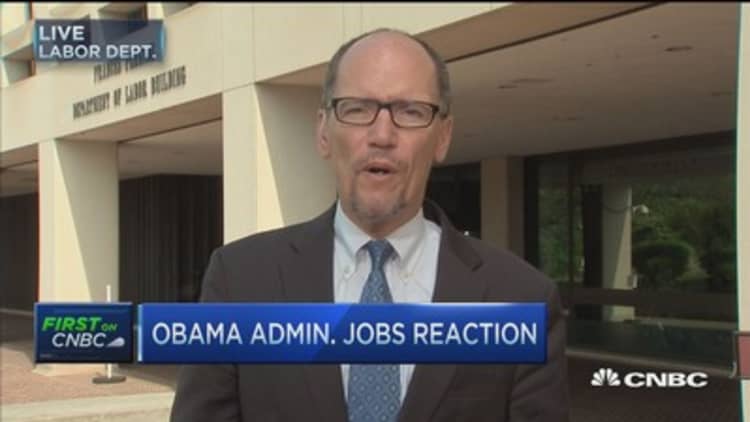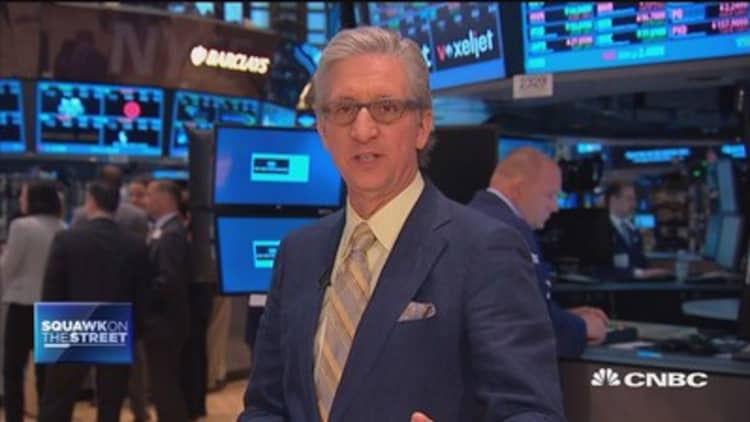



U.S. stocks closed sharply higher on Friday as investors cheered a jobs report that showed economic growth but not enough, in the eyes of most, to warrant central bank tightening immediately. (Tweet This)
Analysts called the April employment figures a "Goldilocks" report because it was just right for gains in stocks. The Dow Jones industrial average held morning gains of 250 points, briefly adding more than 275 points.
The major averages advanced towards records but failed to break them. After a volatile week of trading, the Dow and S&P 500 clung to mild gains for the week, while the Nasdaq was down 0.04 percent for the period.
"Probably best scenario in which the market was hoping for growth but not (so strong) that the Fed needs to hike in June," said Ryan Larson, head of U.S. equity management at RBC Global Asset Management (U.S.).
Read More 'Good' jobs report still weak enough to hold off Fed
He noted that the economy remains on a moderate growth track, as March's disappointing report was revised lower for the weakest figure since June 2012.
April's jobs report showed a creation of 223,000 jobs and an unemployment rate of 5.4 percent. Average hourly earnings increased 0.1 percent, a touch below expectations of 0.2 percent.
The Dow futures more than tripled from about 50 points to as much as 191 points on the jobs report, which was mostly in-line with expectations.
Bond yields edged lower, with the U.S. 10-year ending the week at 2.14 percent, after falling as low as 2.11 in intraday trade. The dropped the most on the data, falling to 0.56 percent after a peak of 0.67 percent overnight.
US Treasury yields week-to-date
The U.S. dollar spiked before holding near lower levels, with the euro weaker at $1.120.
Peter Boockvar, chief market analyst at The Lindsey Group, said the muted gains in wages would likely push out a rate hike and were the primary driver for the jump in stock futures.
Average hourly earnings increased 2.2 percent year-over-year. That's "positive in an almost zero interest rate environment," said Kate Warne, investment strategist at Edward Jones. It "shows consumers have some real earnings growth...but not enough to change how consumers behave."
She expects that continued growth in jobs and wages will contribute to increased consumer spending later in 2015. "That should be a positive catalyst for stocks and for the Fed to raise short-term interest rates later this year," she said.
Tara Sinclair, chief economist at Indeed, also expects increased spending in the coming months. Still, the April "report continues to be a challenge to disseminate what is going to happen later in the year in labor force participation and wages," she said, noting the need for better employment reports in the coming months to show solid improvement in the economy.
She pointed out that the employment-to-population ratio is 59.3 percent, lower than the pre-recession level of 63 percent and the peak of 65 percent in 2000.
Read MoreJobs report takeaway: Q1 weakness might be isolated
Analysts polled by Reuters expected the nonfarm payrolls report to show the creation of 224,000 jobs in April, with unemployment lower at 5.4 percent.
"I think that the Fed will be looking at the market's reaction to the report more than anything else," said Alan Rechtschaffen, financial advisor and senior vice president at UBS Wealth Management Americas."The market is messaging to the Fed they would like to see accommodation and any encouraging numbers will cause stock prices to go up a lot and bonds a little."
The U.S. bond market sold off sharply in the last week, following gains in the German bund yield amid anticipation that Friday's report could induce a rate hike sooner rather than later.
Rechtschaffen said the Fed will likely hold off on tightening until it can better communicate that its policy changes do not require a selloff.
"With (economic) growth, they are hampered in raising rates by market perceptions of what that means," he said.
To be sure, the mostly in-line employment report did not erase the possibility of a June rate hike for some analysts.
"I think the first one will come in June," said Kevin Mahn, chief investment officer at Hennion & Walsh Asset Management. "I think they have enough tangential and enough actual evidence to start a rate hike."
As for Friday's bounce in stocks, Mahn said "I think the market, at least the majority of institutions, believe we are in a secular bull market, so the general trend will be upward."
Art Hogan, chief market strategist at Wunderlich Securities, said that "markets can stabilize here" until the next employment report as growth in the second quarter continues to show signs of slight improvement.
"9 out of 10 (reports) for April's activity have been better than March," he said. " We're heading in the right direction and that should be bullish. We'll still have just a sigh of relief from jobless numbers that did no harm."
In other economic news, wholesale inventories up 0.1 percent in March, versus 0.3 percent gain estimates.
European equities gained, with the FTSE 100 jumping about 2 percent on a more decisive-than-expected U.K. election outcome.
Read More UK election: Now what? Scottish surge and 'Brexit'
Risk assets and bank stocks gained, while the sterling rallied to trade at 1.5413 against the dollar.
"I think the UK elections and overall better news in Europe certainly creates a positive backdrop," Warne said.
AOL reported adjusted quarterly profit of 34 cents per share, two cents above estimates, while revenue was well above forecasts. AOL's results were driven by strength in video, mobile, and programmatic advertising.
Read MoreEarly movers: AOL, WHR, PM, CBS, NOK & more
Bojangles surged 40 percent in its . The restaurant chain priced its initial public offering at $19 per share, above the expected range, giving the company a $680 million value.
Salesforce stock is on watch again today, with Reuters reporting that Microsoft is not considering a bid for the business software maker. Reports earlier this week said Microsoft was considering an offer for Salesforce.
RBC initiated coverage Whirlpool with an "outperform" rating, calling the appliance maker an exceptionally well-managed company that will benefit from a favorable competitive environment in North America.
Oil held near lower levels on Friday but managed to post gains for the week as the rig count posted its 22nd consecutive decline. Earlier, oil declined as strong Chinese crude imports relieved concerns over oversupply.
Crude oil futures settled up 45 cents, or 0.76 percent, at $59.39 a barrel on the New York Mercantile Exchange. Brent crude settled down 15 cents at $65.39 a barrel.
Easing in oil prices helped airlines lead the Dow transports for a second day, with the index up about 1 percent.
The Russell 2000 continued to strengthen, up 1 percent at 1,237.
The small-cap index has recently been in oversold territory near its support level of 1,210, said BTIG chief technical strategist Katie Stockton.
"If we see the rotation into the small caps that will be a positive implication for the breadth of market participation and (investors embracing) a more risk-on mode," she said. "Watching the Russell 2K in the next few days will be more important than watching the SPX."
The Dow Jones Industrial Average closed up 267.05 points, or 1.49 percent, at 18,191.11, with Visa and Boeing leading all blue chips higher.
Visa shares jumped more than 4 percent in afternoon trade on a Bloomberg report that the company is in talks to buy its former subsidiary, Visa Europe.
The closed up 28.10 points, or 1.35 percent, at 2,116.09, with health care leading all ten sectors higher.
The Nasdaq closed up 58.00 points, or 1.17 percent, at 5,003.55.
The CBOE Volatility Index (VIX), widely considered the best gauge of fear in the market, traded near 13.
For every four advancers one declined on the New York Stock Exchange, with an exchange volume of 775 million and a composite volume of nearly 3.4 billion in the close.
High-frequency trading accounted for 47.5 percent of May to date's daily trading volume of about 6.8 billion shares, according to TABB Group. During the peak levels of high-frequency trading in 2009, about 61 percent of 9.8 billion of average daily shares traded were executed by high-frequency traders.
Read More
"The breakout is good in terms of price action," said Lance Roberts, general partner at STA Wealth Management. "The problem is the amount of monetary outflows. More money moving out (means) levitations on lack of volume."
In the short term, he said with the S&P 500 approaching the 2,120 level, "we are breaking out to consolidation into next week."
—CNBC's Peter Schacknow contributed to this report.


